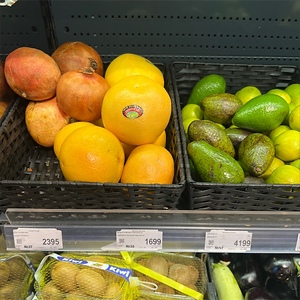


Rio Red Grapefruit
Estimated Inventory, lb : 0
Description/Taste
Rio Red grapefruits are a medium to large varietal, averaging 12 to 15 centimeters in diameter, and have a round to oblate shape with a curved, uniform nature. The variety sometimes develops a depressed indentation around the end, known as a sheep-nose. The skin is semi-thin, smooth, and taut, covered in prominent oil glands creating a pebbled surface. These glands also release aromatic oils, giving the fruits a robust scent. The fruits showcase a yellow-orange hue when ripe, often blushed with faint patches of pink coloring. Underneath the surface, a layer of spongy, white pith encases dark red flesh divided into 10 to 13 segments by thin membranes. The pigmented flesh is firm, aqueous, tender, succulent, and comprised of large vesicles that can separate from one another. The fruits are also generally seedless or contain a few cream-colored seeds. Rio Red grapefruits should feel heavy for their size, indicating a high juice content. The fruits should be relatively smooth and not lumpy in shape, as lumpiness may be a sign of overripening. Rio Red grapefruits have an initially sweet-tart flavor followed by acidic, subtly bitter, fruity, earthy, and floral nuances.
Seasons/Availability
Rio Red grapefruits are available in the winter through late spring.
Current Facts
Rio Red grapefruits, botanically classified as Citrus paradisi, are an American variety belonging to the Rutaceae family. The mid-to-late-season fruits develop on large, evergreen trees reaching 4 to 7 meters in height, sometimes growing larger, and appear in clusters like grapes on the tree, giving the fruits their grapefruit moniker. Rio Red grapefruits were created in Texas in the late 20th century and were selected as a commercial cultivar for their dark red, pigmented flesh, sweet-tart taste, and juicy nature. The variety is also sold under the brand Rio Star® and has become one of the most popular red-fleshed grapefruits in American markets. Rio Red grapefruits are easy to grow, productive, and hold well on the tree, being left until the fruits are fully ripe and develop a sweeter taste. Once mature, the fruits are picked by hand and are sold for fresh eating. Since their release, Rio Red grapefruits have expanded beyond cultivation in Texas and are commercially produced and grown in home gardens worldwide. Rio Red grapefruits are consumed raw or cooked and are utilized in a wide array of sweet or savory preparations.
Nutritional Value
Rio Red grapefruits are a source of fiber to regulate the digestive tract, potassium to balance fluid levels within the body, vitamin A to maintain healthy organs, and vitamin C to strengthen the immune system. The fruits also provide calcium to protect bones and teeth, magnesium to control nerve functions, phosphorus to repair cell tissues, and other nutrients, including manganese, vitamin D, lutein, vitamin B6, and folate. The variety’s dark red coloring is created from the presence of lycopene and beta-carotene, and the flesh is high in water, adding hydration to the body. The bitter taste in grapefruits is caused by a natural flavonoid called naringin. This compound is found in lower quantities in Rio Red grapefruits versus other red grapefruit varieties.
Applications
Rio Red grapefruits have a sweet, tart, and subtly bitter taste suited for fresh and cooked preparations. The variety is popularly eaten out of hand and is favored for its sweet taste, juicy flesh, and tender nature. Rio Red grapefruits can be peeled, segmented, and eaten or sliced in half, and the flesh scooped with a spoon. The variety is also popularly juiced and mixed into cocktails such as Palomas. The sweet-tart juice has a dark red, jewel-toned coloring and is combined with other fruit juices to make a punch or stirred into sparkling beverages for added flavoring. When consuming fresh, it is recommended to discard the membranes surrounding the flesh to create a sweeter taste. Rio Red grapefruit segments can be tossed into salads, chopped into salsa, or used as a fresh topping over parfaits, tacos, ceviche, or seafood. It can also be simmered into various jams, jellies, and syrups or used to flavor fillings for baked goods and pastries. Rio Red grapefruits pair well with avocado, herbs including basil, rosemary, and mint, and cheeses such as feta, goat, and cottage. Whole, unwashed, and unopened Rio Red grapefruits will keep for 1 to 2 weeks when stored at room temperature in a cool, dry, and dark location. The fruits will keep for up to six weeks when stored in the refrigerator’s crisper drawer.
Ethnic/Cultural Info
Red grapefruits, including Rio Red grapefruit, were declared the state fruit of Texas. Red grapefruits were chosen in 1993 as the fruits were first created in the state and are one of the most important agricultural crops. It is said grapefruit trees have contributed more revenue for Texas growers than any other fruit tree grown in the state. Ruby Red grapefruits, the parent to Rio Red, were also one of the first patented varieties in the United States, being protected in 1929. Rio Red grapefruits were developed from Ruby Red and are distinct as they have a deeper coloring and sweeter taste. The variety was named Rio after the Rio Grande Valley, the fruit’s site of origin. The Rio Grande Valley is famous for its warm temperatures, humidity, and windy nature, factors that help the fruits develop their signature sweet taste.
Geography/History
Rio Red grapefruits are native to the United States and were developed in Texas in the late 20th century. Grapefruits, in general, are thought to be a natural mutation and hybrid of a sweet orange, Citrus sinensis, and a pummelo, Citrus grandis. The first versions of the fruit were found in the West Indies in the mid-18th century, and by the 19th century, the hybrid fruits were named grapefruit as they can grow in clusters of up to twenty fruits. Grapefruits were carried to the United States through French or Spanish settlers, with Count Odette Phillipe, a Spanish don, notably involved in the fruit’s introduction into Florida in 1823. Spanish missionaries are thought to have brought the fruit to Texas, and historically, the grapefruit varieties were white, later adding pink types. Grapefruits were first recorded in Texas in 1893, and real estate developer John H. Shary is credited as the “Father of the Citrus Industry” in Texas. Shary purchased land for grapefruit cultivation in 1914 and helped spur the commercial grapefruit industry. In 1929, Texas grower A.E. Henninger noticed a mutation on one of his pink marsh grapefruit trees that had red flesh and was sweeter than other varieties. Henninger later patented the variety under ruby red grapefruit, and in the 1920s and 1930s, other red-fleshed mutations appeared in orchards throughout Texas. In the 1960s and 1970s, more mutations were found with even darker red flesh, and breeder and scientist Dr. Richard Hensz began studying red-fleshed cultivars at the Texas A&I Citrus Center, now known as the Texas A&M Citrus Center. Dr. Hensz took ruby red budstock and utilized ionizing radiation through x-rays and thermal neutrons to encourage dark red flesh. A new variety was released in 1984, called 1-48S, and was later renamed Rio Red grapefruit. Rio Red quickly became one of the most planted red grapefruits in Texas, especially after several periods of freezes led to growers ripping out their old trees in exchange for Rio Red. The variety is commercially sold as a specialty grapefruit. Today, Rio Red grapefruits are still grown in the Rio Grande Valley of Texas and are also cultivated in commercial and home gardens in Texas, Florida, Arizona, and California. Outside of the United States, the variety is grown in Spain, South Africa, Turkey, Israel, and Argentina.
Recipe Ideas
Recipes that include Rio Red Grapefruit. One









